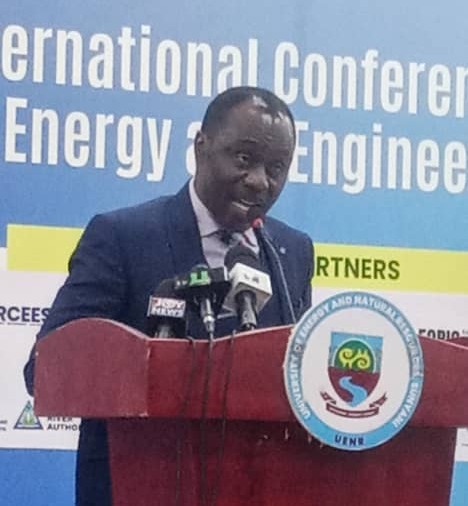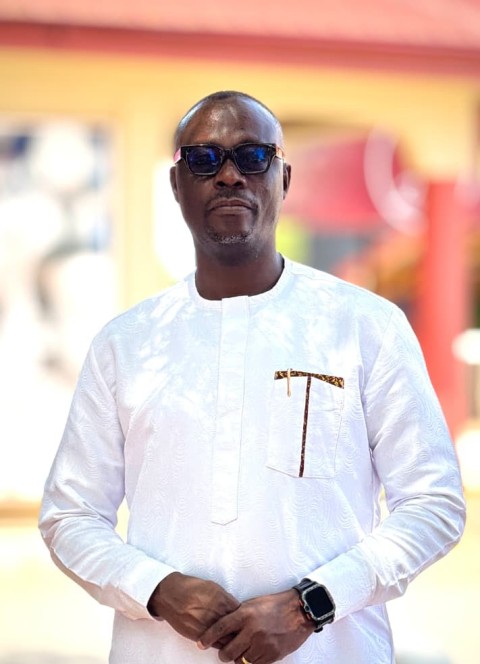On Wednesday October 1, 2025, the Vice Chancellor of the Sunyani Technical University (STU) Ing. Prof. Kwadwo Adinkrah-Appiah delivered a Keynote Address at the Second International Conference on Energy and Engineering (ICEE ’25) organized by the University of Energy and Natural Resources (UENR) in Sunyani. The three-day Conference was on the theme: “Engineering the Future: Smart Innovations for Sustainable Energy, Agriculture, Infrastructure, and Climate Resilience.”
Ing. Prof. Adinkrah-Appiah spoke on the topic: “Smart and Renewable Energy Systems – Advancing a Sustainable and Reliable Energy Mix in Ghana.”
rbnewshub.com brings you the full text of Ing. Prof. Adinkrah-Appiah presentation at the conference which assembled researchers, academics, industry professionals, policymakers, and students who took turns to make presentations that sought to address pressing global and local challenges in energy, engineering, agriculture, and sustainability.
Introduction
I bring you warm greetings from Sunyani Technical University, STU, the Institution with a vision to become the preferred Technical University in Emerging Technologies. Indeed, my University’s Vision resonates with the objectives of the 2nd International Conference on Energy and Engineering (ICEE 2025), with the General Theme:Engineering the Future: Smart Innovations for Sustainable Energy, Agriculture, Infrastructure, and Climate Resilience. And it is a great honour for me to join you here at the University of Energy and Natural Resources (UENR) to be part of this impactful Conference.
Prof. Chair, globally, we are witnessing an accelerated energy transition due to an imperative driven by climate change, technological shifts, and economic constraints. Solar, wind, and other renewable energy systems are undergoing rapid expansions, and as nations strive to modernize, renewable energy systems are no longer just an option but indispensable for energy security, resilience, and sustainable development.
I am here this morning to give a Keynote address on the Topic: “Smart and Renewable Energy Systems – Advancing a Sustainable and Reliable Energy Mix in Ghana”. And in this address, I will discuss 5 Key areas as follows:
1. Grid Integration
Grid integration involves connecting renewable energy sources to existing power grid for stable and efficient power supply. Renewable generation, especially solar and wind, is inherently variable. The challenge is to maintain grid stability while accommodating fluctuations in supply. Unfortunately, many national grids, including Ghana’s, were not designed for bi-directional flows or high penetration of variable energy. The transition therefore requires smart architecture supported by digital technologies.
One of the most powerful enablers for Grid Integration is a Digitalized Smart Grid, whereby sensors, real-time monitoring, two-way communication, and advanced control systems are deployed.
Regional interconnection offers another powerful solution. Ghana is part of the West African Power Pool, which enables cross-border energy exchange. In times of surplus renewable energy generation, Ghana could export power to neighboring countries; conversely, import in lean periods to stabilize supply. Such interdependence can optimize resource utilization and stabilize markets.
2. Decentralized Energy Systems and Micro-grids
Turning to decentralized systems and micro-grids, the opportunities are equally compelling. In many low-income and rural areas, extending the centralized grid is economically unviable. In Africa, about 45% of rural communities may be more cost-effective if they are served by mini or micro-grids rather than extending high-voltage lines. In Ghana, especially, renewable-powered mini-grids are increasingly seen as the least-cost option in remote areas. In such communities, hybrid micro-grids combining solar, small hydro, and battery facilities can deliver stable electricity.
Prof. Chair, examples of micro-grid projects in Ghana include the Kaleo Solar Power Station in the Upper West region which is already feeding into the national grid via GRIDCo. Also, Ghana’s rural electrification initiative aims to electrify several rural communities, using renewable technologies.
The government’s target, enshrined in policy frameworks, is to reach 10% renewable generation by 2030. Meeting this goal demands aggressive upscaling of both grid-level and decentralized pathways. In this direction, I underscore three approaches:
- Smart Virtual Power Plant (VPP) Aggregation: This involves combining many small-scale distributed generators into virtual portfolios that can feed into the main grid. This will allow distributed energy to act as a dispatchable resource, enabling revenue streams and better integration.
- Blockchain-Based Peer-to-Peer (P2P) Energy Trading: This approach allows households or businesses with surplus solar generation to trade energy directly with neighbours, strengthening local energy markets. This decentralizes energy markets and fosters autonomy.
- Adaptive Financing via “Energy as a Service” (EaaS): Instead of upfront capital expenditure, communities or institutions pay for energy as a managed service. The micro-grid operator installs, maintains, and operates the system; users pay a tariff or subscription. This shifts risk away from communities with limited capital.
These innovations require enabling institutions and policies. The regulatory framework must allow interconnection of micro-grids, define standards for Virtual Power plant (VPP) aggregation, and permit Peer-to-Peer (P2P) trading. The Renewable Energy Act, 2011 (Act 832) offers a legal basis in Ghana, but further legislative instruments and guidelines are needed to accommodate these emerging models.
Universities and research institutions in Ghana must lead capacity building by training engineers and operators in micro-grid design, inverter control, smart energy systems, and data analytics. Collaboration with international partners, private sector actors, and multilateral agencies can accelerate technology transfer, pilot deployments and financing opportunities for successful implementation of micro-grid projects.
3. Energy Efficiency and Demand Side Management
Energy efficiency and demand side management represent critical but often underemphasized pillars of a resilient energy future. Their importance is particularly pronounced in Ghana, where energy systems face persistent pressures from rising demand and structural inefficiencies.
Electricity consumption in Ghana has grown steadily over the past decade, largely driven by population growth, industrialization, and rapid urbanization. According to the Energy Commission, peak electricity demand surpassed 3,600 megawatts in 2024, and it is projected to continue increasing in the coming years.
Current patterns of energy use in Ghana highlight significant inefficiencies across multiple sectors. In households, outdated appliances such as second-hand refrigerators and inefficient light bulbs persist despite regulatory efforts to phase them out. Industrial facilities often operate with inefficient motors and inadequate power factor correction systems, resulting in excessive consumption and productivity losses.
On the supply side, Ghana faces systemic challenges, with nearly 20% of electricity generated lost through technical and commercial inefficiencies. Such losses directly influence tariff levels and undermine the financial sustainability of utilities.
Addressing these challenges requires a multifaceted approach in which demand side management (DSM) plays a pivotal role. DSM initiatives must extend beyond technical interventions to include consumer engagement and behavioral change. Awareness campaigns, such as the Energy Commission’s “Save a watt campaign,” provide an important foundation but require revitalization, upscaling, and targeted outreach to specific consumer groups.
Equally, institutions of higher learning must integrate energy literacy and efficiency principles into their curricula. Simple policies such as switching on air condition units only after 11.00 am daily in offices and classrooms, as being implemented by STU, could significantly help inculcate DSM principles in both students and staff.
4. Green Hydrogen and Other Storage Innovations
Energy storage solutions are also essential. These storage systems smooth out mismatch between generation and demand. An example is the Bui Hydro-Solar Hybrid Project, where floating solar and ground-mounted Photovoltaic (PV) systems are integrated with existing hydropower infrastructure to produce hybrid renewable energy output. As battery and even emerging long-duration storage costs decline, such hybrid systems will become increasingly viable in developing countries like Ghana.
Green hydrogen is produced by electrolysis of water, using electricity, and can later be used in fuel cells, combustion turbines, or blended into natural gas pipelines. Because hydrogen stores energy in chemical bonds, it offers high energy density per mass and can be stored over long durations without self-discharge. These advantages are unmatched by conventional batteries for specific use cases. Coupled with smart systems, hydrogen becomes another asset in the energy optimization toolbox.
In February 2025, Ghana launched its first green hydrogen pilot system at the Salesian School in Tema, coupling solar power to an electrolyzer, hydrogen storage, and fuel cell to advance local renewable energy solutions. This pilot project offers a tangible proof of concept for integrating hydrogen into Ghana’s energy mix.
Given Ghana’s abundant solar irradiance and hydropower base, hybrid systems such as combining solar-electrolyzer-hydrogen storage with existing hydroelectric infrastructure is a feasible option. From a policy and investment perspective, Government can offer fiscal incentives such as tax holidays and duty exemptions via Ghana Investment Promotion Centre (GIPC) or Free Zones mandates, which may favour green hydrogen projects.
5. Energy, Society and Environment
At the intersection of energy, society, and the environment, the transition to renewable energy presents both opportunity and responsibility. The International Energy Agency (IEA) estimates that nearly Five Million premature deaths annually are attributable to ambient and household air pollution, much of which ties back to fossil fuel combustion. Transitioning to smart renewable energy systems thus offers opportunity to reduce these harms while expanding access.
While electrification rates have reached about 89 percent in Ghana, reliability remains a challenge, particularly in rural areas. If communities experience frequent outages, they will revert to diesel generators or biomass, undermining environmental goals.
Therefore, renewable energy systems should guarantee critical loads while allowing non-essential loads to adjust according to availability. Weaving energy, society, and environment, I propose Three Strategies:
- Community-integrated eco-energy parks: Small geographic zones where renewable generation, agricultural production, wastewater treatment, and local enterprises coexist. This holistic “energy-environment-society nexus” will ensure synergies and holistic sustainability.
- Dynamic carbon and social credits: These are systems that track and reward local reductions in greenhouse emissions, water savings, or avoided deforestation, and distribute credits or payments to communities.
- Adaptive energy literacy as a social infrastructure: Communities need energy education, decision-making tools, dashboards, and participatory governance platforms.
Ghana’s Energy Transition Framework 2023 sets ambitious goals including: Universal access to electricity, Expanding renewable share, and Ensuring environmental sustainability. Government aims to extend electricity access to more deprived communities and integrate more micro-grids. Importantly, one policy objective is to “ensure that energy is produced, transported and utilized in an environmentally sustainable manner.” To realize this objective, the integration of social and ecological principles into project conceptualization and design is inevitable.
However, several challenges remain, including legacy fossil-fuel systems, tariff distortions, subsidies, and significant debts owed to power producers. Addressing this imbalance requires correcting the distortions and designing incentives that promote both inclusion and environmental integrity.
To achieve this, priority should be given to inclusive procurement policies such as the following:
- Mandating that 20–30% of new solar or micro-grid contracts incorporate local labour, ownership, or capacity-building components.
- Establishing financing windows dedicated to rural or underserved communities, with concessional terms or targeted grants.
- Implementing performance-based contracts that link subsidies or incentives to social outcomes such as the number of low-income households connected, hours of reliable service, or the share of revenues retained locally.
These policy levers can play a critical role in advancing energy justice and ensuring that the benefits of renewable energy transitions are distributed equitably.
Conclusion
In conclusion, Prof. Chair, smart and renewable energy systems must transcend mere engineering. They must be integrated into the fabric of society and grounded in ecological responsibility. The urgency is acute as climate change stress rises, energy access inequalities persist, and ecosystems remain fragile. These conditions make it imperative that the energy transition prioritizes renewable solutions tailored to local realities. By boldly seizing these opportunities, we can reshape our energy landscape into one that is secure, inclusive and provides a sustainable and reliable energy mix.
Thank you and may God bless us all.





